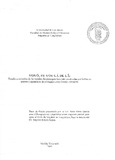| dc.rights.license | http://creativecommons.org/licenses/by-nc-sa/3.0/ve/ | |
| dc.contributor.advisor | Zapata, Argenis | |
| dc.contributor.author | García, Rosa Elena | |
| dc.date.accessioned | 2011-01-10T14:40:34Z | |
| dc.date.available | 2011-01-10T14:40:34Z | |
| dc.date.issued | 2011-01-10T14:40:34Z | |
| dc.identifier.uri | http://www.saber.ula.ve/handle/123456789/32122 | |
| dc.description.abstract | En este trabajo se hizo un análisis contrastivo para comparar acústicamente las
vocales orales y nasales del portugués brasileño producidas por hablantes nativos y
aprendices principiantes de portugués como lengua extranjera y determinar si existían
diferencias en la conformación formántica de ambas producciones. Frases marcos
portadoras de las vocales del portugués fueron grabadas y procesadas con el software
Praat. Se elaboraron triángulos acústicos con los valores de los dos primeros
formantes de las vocales. EI análisis contrastivo revelo los siguientes resultados. En
relación con las vocales orales producidas por los aprendices, (1) Todas las vocales
son más altas y posteriores que las de los hablantes nativos. (2) Las vocales / ϵ e / se
encuentran muy próximas; sin embargo, la vocal / ϵ / de los principiantes es mas
posterior y más alta: que la vocal /e/ de los nativos. (3) Al igual que las vocales / ϵ e /
las vocales / Ɔ o / se encuentran muy cerca; no obstante, las vocal / Ɔ / de los principiantes tiende a ser mas anterior y más baja que la /o/ de los nativos. (4) La vocal / e/ tiende a ser más baja que la producida por los nativos. (5) La vocal /i/ de los principiantes se hace frontal casi como la /i/. En relación con las vocales nasales del portugués producidas por los principiantes, (1) Todas son más altas que la de los nativos. (2) Las vocales / ȋ ȇ/ se posteriorizan. (3) La vocal /ῠ/ se retrae. (4) Las vocales nasales la o u/ se mantienen en posicion posterior. Finalmente, se propone el uso de análisis acústico como herramienta pedagógica en la enseñanza de segundas lenguas. | es_VE |
| dc.description.sponsorship | Universidad de Los Andes | es_VE |
| dc.rights | info:eu-repo/semantics/openAccess | |
| dc.subject | Acústica | es_VE |
| dc.subject | Vocales | es_VE |
| dc.title | Estudio contrastivo de las vocales del portugues brasilei'io producidas por hablantes nativos y aprendices de portugues como lengua extranjera | es_VE |
| dc.type | info:eu-repo/semantics/masterThesis | |
| dc.description.abstract1 | In this research, a contrastive analysis was done to acoustically compare the oral
and nasal vowels of Brazilian Portuguese as produced by native speakers and
beginning learners of Portuguese as foreign language in order to determine whether
there were differences in the formant configuration of both productions. Sentence
frames containing the Portuguese vowels were recorded and processed with the
software Praat. Acoustic triangles were designed with the values of the first two
formants of the vowels. The contrastive analysis revealed the following results. In
connection with the oral vowels produced by the learners, (1) All the vowels are
higher and further back than those of the native speakers. (2) The vowels /£ el are
very close; however, the vowel 181 of the beginners is more back and higher than the
vowel leI of the native speakers. (3) Like the vowels 18 el, the vowels I'J 01 are very
close; nevertheless, the vowel I'JI of the beginners tends to be more anterior and
lower than the 101 of the native speakers. (4) The vowel luI tends to be lower than
the one produced by the native speakers. (5) The vowel leI of the beginners becomes
front almost like /i/. In connection with Portuguese nasal vowels produced by the
beginners, (1) All are higher than those of the native speakers. (2) The vowels II el
become back. (3) The vowel luI becomes back. (4) The nasal vowels la 6 ul remain
in the back position. Finally, the use of acoustic analysis as pedagogic tool is
proposed in the teaching of second languages. | es_VE |
| dc.description.grado | Maestría | es_VE |
| dc.publisher.pais | Venezuela | es_VE |
| dc.subject.facultad | Facultad de Humanidades y Educación | es_VE |
| dc.subject.institucion | Universidad de Los Andes | es_VE |
| dc.subject.keywords | Acoustically | es_VE |
| dc.subject.keywords | Vowels | es_VE |
| dc.subject.thematiccategory | Artes y Humanidades | es_VE |
| dc.subject.tipo | Tesis | es_VE |
| dc.type.media | Texto | es_VE |


